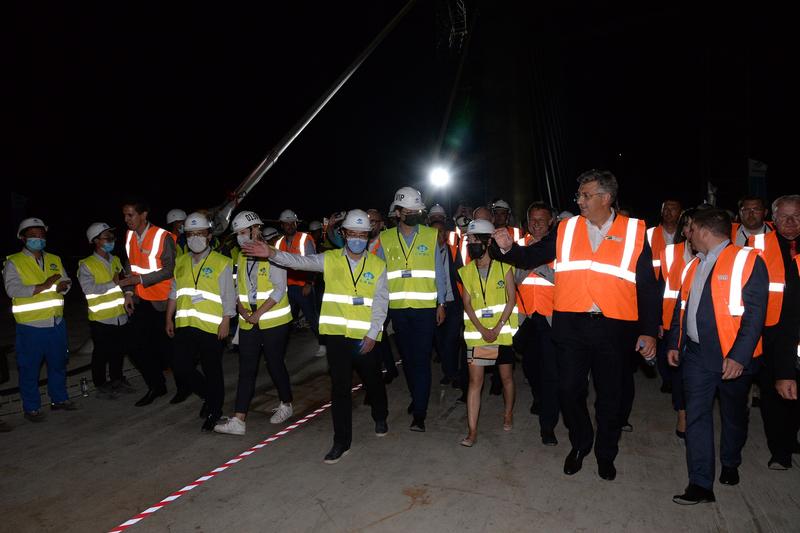 A man waves a Croatian flag on the Peljesac Bridge in Komarna, southern Croatia, as it opens to traffic on Tuesday. A Chinese consortium, led by China Road and Bridge Corp, won the bid to build the bridge and its access roads in 2018. (PHOTO / AP)
A man waves a Croatian flag on the Peljesac Bridge in Komarna, southern Croatia, as it opens to traffic on Tuesday. A Chinese consortium, led by China Road and Bridge Corp, won the bid to build the bridge and its access roads in 2018. (PHOTO / AP)
For Talman Damtare and Ana Vulic, a couple that helped build the Peljesac Bridge linking two parts of Croatia separated by a sliver of Bosnia and Herzegovina, nothing makes them more proud than driving past the structure from a distance with their young daughter.
Damtare, a customs clearance assistant for the project, said he would always point at the majestic bridge and tell his daughter: “Look, that is the bridge mom and dad built with Chinese friends.”
Damtare, from Togo in West Africa, and Vulic, a native Croat, have worked on the project for more than three years. They first met in the summer of 2009 in Nanjing in East China’s Jiangsu province, when they were students at Nanjing Normal University.
“The project has not only brought family reunion for us, but the good feeling of participating in a great cause. The bridge means so much for everyone in Croatia,” said Damtare, referring to the days years ago when he was working in Shanghai while his wife went back to Croatia during her pregnancy.
The 2.4-kilometer-long, 23.6-meter-wide, four-lane bridge officially opened to traffic on July 26 after four years of construction. It was built by the China Road and Bridge Corporation, or CRBC, for which the couple works.
The bridge, which stands 55 meters above sea level and has pylons 124 meters in height,, connects the town of Brijesta on the Peljesac Peninsula with the town of Komarna. It is a feat of construction that opens up the peninsula to the rest of the country by road. The structure crosses the Mali Ston Bay over the Adriatic Sea.
“This will facilitate the smooth flow of goods and people, especially at the peak of the tourism season,” the European Commission said when approving the spending of 357 million euros ($362 million) from its Cohesion Policy funds for the project in June 2017. The money accounts for 85 percent of the total cost, with the rest covered by Croatia.
The commission said the bridge “will significantly improve the everyday life of Croatians, through reducing the travel time between Dubrovnik and Split”.
The two hot tourist destinations of Split and Dubrovnik are separated by the Neum Corridor, a strip of the Adriatic Sea coastline that is part of Bosnia and Herzegovina and which, until July 26, has been the only land-based transport route between Dubrovnik and the rest of mainland Croatia.
That has meant people have had to travel about 9 km within Bosnia and Herzegovina and pass the European Union’s external border controls twice, a requirement that can cost a few hours in the summer peak tourist season.
Dubrovnik, on the UNESCO list of World Heritage sites since 1979, draws more than a million foreign tourists each year not only for its outstanding medieval architecture and fortified old town dating to the 7th century, but also as one of the sites for the popular US fantasy drama TV series Game of Thrones.
Croatia first started the construction of the Peljesac Bridge in 2007 but the project was halted in 2010 due to serious financial strains.
CRBC began work on the project on July 30, 2018, just three months after it led a Chinese consortium to win a public tender by Hrvatske Ceste, the state-owned company responsible for Croatia’s public roads.
Despite the enormous challenges posed by the COVID-19 pandemic over the past two and a half years, the Chinese company managed to deliver the bridge on scheduled.
The spans of the bridge were connected on July 28, 2021.
 Croatian Prime Minister Andrej Plenkovic acknowledges the efforts of workers as he walks across the bridge on July 29, 2021. (GAO LEI / XINHUA)
Croatian Prime Minister Andrej Plenkovic acknowledges the efforts of workers as he walks across the bridge on July 29, 2021. (GAO LEI / XINHUA)
Zeng Linghua, the deputy project manager, has been working on the bridge since day one. He said he feels proud that the project has met the high standards required by China, Croatia and the European Union in terms of quality, safety and environmental protection, and that the structure has won praise from many institutions.
“It’s not just of great strategic significance to Croatia’s transport, economy and people’s livelihoods but (also) significant in encouraging Chinese construction companies going global and in promoting the Belt and Road Initiative,” Zeng said, referring to China’s global infrastructure program.
He recalled the huge challenges during the outbreak of the pandemic in 2020 when there were 800 Chinese workers on the construction site at the peak time. Ensuring everyone’s safety against the then little-known coronavirus was a top priority. And due to the well-planned safety and preventive measures, no one was ever infected.
Zeng said that as the first Chinese company undertaking a project funded by the European Union, CRBC successfully adapted to the European market.
“In a word, it is a high standard,” he said, referring to a wide range of achievements, from the bridge’s steel structure obtaining Europe’s highest EXC4 Class classification to the strict protection of marine life due to the project’s location in an ecological conservation area.
Xiong Cheng 1, the world’s largest pile-driving barge, was deployed for driving the world’s longest steel piles, at 130.6 meters long, to lay the foundations for the bridge.
Zeng also attributed the success to the relentless efforts by the team to familiarize and adapt to the EU laws and regulations.
Natali Kolega, who began work on the project as a field engineer after she graduated from the University of Zagreb in 2018, described the job as a great start to her career.
“It means so much for me. It has helped me grow up and transformed me from a student to an engineer. I will forever remember the experience here,” she said.
Liu Jiaxi, a Chinese field engineer, has worked on the project for the past four years. He described the experience as a process of striving for perfection under multiple challenges.
“It helps me better understand the word ‘craftsmanship’,” said Liu, who participated in the construction of the 55-km Hong Kong-Zhuhai-Macao Bridge before joining the Croatia project.
Chinese Premier Li Keqiang, accompanied by his Croatian counterpart Andrej Plenkovic, visited the Peljesac Bridge construction site on April 11, 2019. They both called the project a good example of what can be accomplished with stronger ties between the two countries.
Premier Li has called on China and the European Union to carry out cooperation and learn from each other on the basis of mutual respect and equal treatment, which conforms to the fundamental and long-term interests of both sides.
He made the remark in an address via video link on July 27 at the opening ceremony of the China-built Peljesac Bridge which connects Croatia’s mainland with its southernmost region.
Li, who pressed the start button on a pile driver at the bridge’s construction site three years ago with Croatian Prime Minister Plenkovic, hailed the on-schedule completion of the bridge as a remarkable achievement.
Li said the bridge is an embodiment of China-EU cooperation and a model of mutually beneficial cooperation between them that complements each other’s advantages.
Under the current circumstances, China and the EU should jointly safeguard the rules-based multilateral trading system with the World Trade Organization at its core and work together to build an open world economy, he said.
The opening of the Peljesac Bridge comes nine years after Croatia joined the EU on July 1, 2013, and five months before the country is expected to switch currencies from the kuna to the euro on Jan 1.
Plenkovic said recently that his country wants to enter the EU’s borderless Schengen Area in January.
Petr Fiala, prime minister of the Czech Republic, said on July 7 that his country, which has assumed the presidency of the Council of the EU in the second half of the year, will strive to ensure that the EU grants Croatia entry into the passport-free area.
Reflecting on her time at the construction site as a field engineer, Kolega said she enjoyed all the moments with her colleagues, whether during work, partying or on other occasions.
She also loves the Chinese sweet rice congee served by the Chinese chefs there but admits that some Chinese dishes are just too spicy for her.
For Damtare, spicy chicken and egg custard are his favorite food served at the construction site.
“I love all the Chinese food here,” he said.
Mo Jingxi in Beijing contributed to the report.


